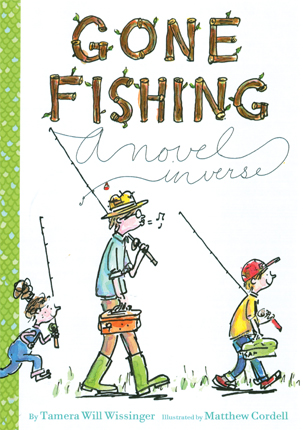Full Text Reviews: Booklist - 03/15/2013 Sam can’t wait to go fishing with his father, until his little sister, Lucy, worms her way into their trip. Told in engaging verse that’s just the right depth and length for chapter-book readers, Wissinger’s novel artfully captures both the thrill of the catch and the aggravation of younger siblings (especially when they’re catching more fish). Loosely drawn black-and-white sketches highlight Sam’s moods, including his eventual excitement as he finally manages to reel in the big one. Wissinger identifies each poem format, from haiku, ode, and double dactyl to blues poem, counting poem, and list poem, and even includes poems told in multiple voices. The author extends the fishing metaphor with an appended “Poet’s Tackle Box,” which explains how rhyme and rhythm work as well as such poetry “bait” as alliteration, hyperbole, and onomatopoeia. She also describes each poem format used and provides a bibliography of additional poetry resources. A solid, entertaining story to hook children on poetry. - Copyright 2013 Booklist. Bulletin for the Center... - 05/01/2013 Narrator Sam is looking forward to a day out on the lake, just himself, his dad, and lots of hungry, gullible fish. No such luck: his younger sister, Lucy, talks Dad into taking her along and packs up enough inappropriate gear for an extended vacation. Any kid who’s read a lighthearted family novel will see what’s coming: it’s noisy Lucy who gets the first bite and who scores the biggest haul, with Sam coming second with one good sized catfish (Dad leaves empty-handed). Sam pulls through his jealous funk, though, when Lucy takes her own accomplishment with admirable nonchalance, saving her excitement for describing to the family back home how hard Sam fought to land his catfish. The trajectory may be predictable, but the format is less conventional: all of Sam’s episodes take the form of poems, each discreetly labeled by its poetic form, which is then defined at the end of the book. The poems are accessible by title (in a table of contents that suggests encouragingly tiny chapters), and they are cross referenced with other similarly constructed pieces in the separately alphabetized lists of poetry techniques and forms: “HYPERBOLE . . . In ‘Can’t Go Fishing Yet Blues,’ ‘Lucy is the slowpoke of the year’ is hyperbole. It also occurs in ‘Fish Tales’ when Sam says his fish ‘must’ve weighed a ton.’” An occasional conundrum in the back matter may send classroom readers scurrying for explanation (why is the limerick also a cinquain, and why isn’t it labeled as such?), but most will just enjoy the notion that there are as many ways to tell a tale as to catch a fish. Plenty of cartoony graytone line and watercolor artwork embellishes the text, and a bibliography of poetry books and websites (with one stray fishing book) is appended. EB - Copyright 2013 The Board of Trustees of the University of Illinois. School Library Journal - 07/01/2013 Gr 1–4—This novel in verse successfully builds a story filled with anticipation, family humor, and sibling rivalry. Wissinger adroitly uses a variety of poetic forms to express nine-year-old Sam's excitement about an upcoming outing with his father: "Hip-hip, hooray!/It's fishing day./Yo-ho yippee!/Just Dad and me." To Sam's consternation, his annoying little sister decides that she wants to go, too. She packs for the trip by filling Sam's tackle box with her toys. "Where's my stringer?/Something's wrong!/The princess doll does not belong!" Sam is even more despondent when her singing helps her catch a handful of fish even before he has caught one. The trip vastly improves when he lands a sizable catfish, leading Lucy to gush with pride for him. "You caught one Sam!/Lucy scoots close to me./A big one, too!/I didn't even look/when she caught/her first fish./But she cheered for me/Maybe I was wrong/about bringing her along." Teachers will appreciate the seamless introduction to different poetic forms including rhyming lists, concrete poems, ballads, and haiku. Wissinger deftly plies her craft to ensure that the use of poetry enhances the readability of the story. She includes a "Poet's Tackle Box" to complete this solid introduction to poetic form. Cordell's whimsical line drawings complement the poetry by capturing the adventurous spirit and humor that this story demands. Hearing it aloud, children will appreciate the rollicking tale and the lyrical verse, while young readers will be able to enjoy the book independently. This book might inspire some to pursue an interest in fishing, but it will surely encourage all of them to delve into the world of poetry.—Carole Phillips, Greenacres Elementary School, Scarsdale, NY - Copyright 2013 Publishers Weekly, Library Journal and/or School Library Journal used with permission. Loading...
|



